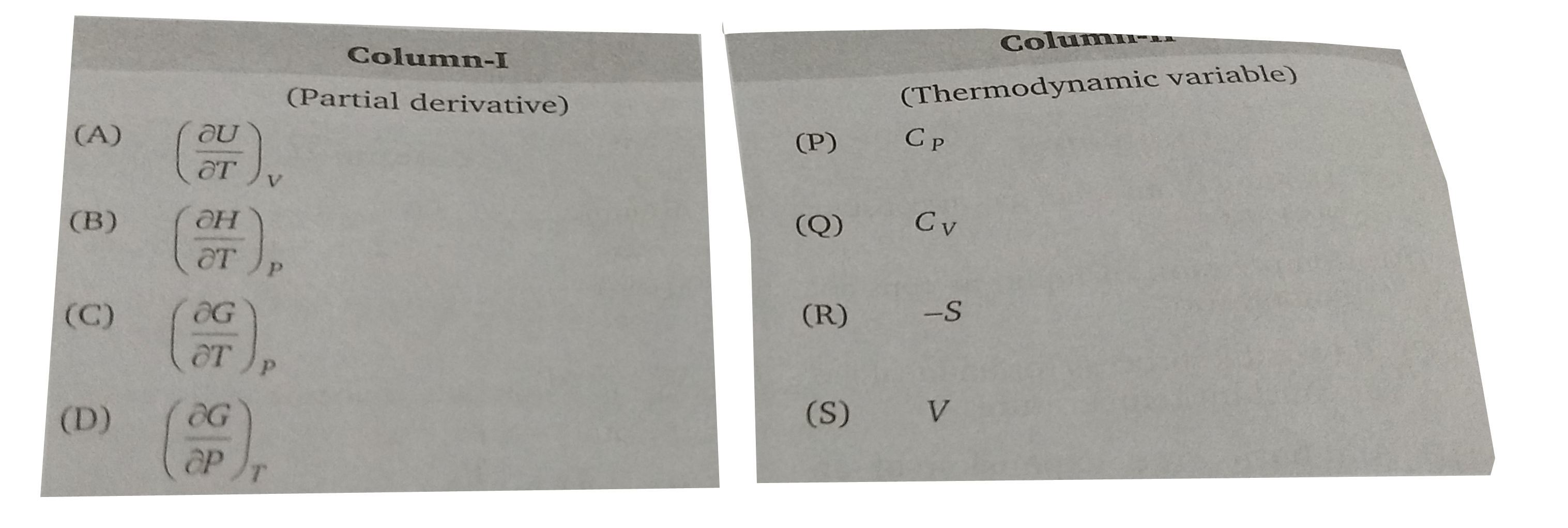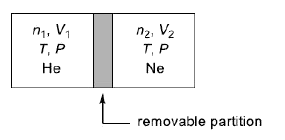A rigid and insulated tank of 3m3 volume is divided into two compartments. One compartment of volume of 2m3 contains an ideal gas at 0.8314 Mpa and 400 K while the second compartment of volume of 1m3 contains the same gas at 8.314 Mpa and 500 K. If the partition between the two compartments is rptured, the final temperature of the gas is :Solution in Punjabi
420 K
450 K
480 K
None of these
The correct Answer is:C
Mole of the gas in the first compartment
n1=P1V1RT1=−0.8314×106×28.314×400=500
Similarly, n2=2000
The tank is rigid and insulated hence w = 0
and q = 0 therefore ΔU=0
Let Tf and Pf denote the final temperature and pressure respectively
ΔU=n1CV,m[Tf−T1]+n2CV,m[Tf−T2]=0
500(Tf−400)+2000(Tf−500)=0
Tf=480K
Topper's Solved these Questions
- BOOK - NARENDRA AWASTHICHAPTER - THERMODYNAMICSEXERCISE - Level 3 - One Or More Answers Are Correct1videos
THERMODYNAMICS
- BOOK - NARENDRA AWASTHICHAPTER - THERMODYNAMICSEXERCISE - Level 3 - Match The Column2videos
THERMODYNAMICS
- BOOK - NARENDRA AWASTHICHAPTER - THERMODYNAMICSEXERCISE - Level 2 (Q.1 To Q.30)1videos
THERMODYNAMICS
- BOOK - NARENDRA AWASTHICHAPTER - STOICHIOMETRYEXERCISE - Level 3 - Subjective Problems20videos
STOICHIOMETRY
Similar Questions
Assume ideal gas behaviour for all the gases considered and neglect vibrational degrees of freedom. Separate equimolar sample. Separate equimolar samples of Ne, O2 , CO2 and SO2 were subjected to a two process as mentioned. Initially all are at same state of temperature and pressue.
Step I → All undergo reversible adiabatic expansion to attain same final volume, which is double the original volume thereby causing the decreases in their temperature.
Step → After step I all are given appropriate amount of heat isochorically to restore the original temperature.
Mark the correct option(s) :02:17View SolutionMatch the following columns
 02:38View Solution
02:38View SolutionWrite structure of 2,2-dimethylheptane.
03:35View SolutionWhat volume of a liquid (in L) will contain 10 mole ? If molar mass of liquid is 280 and its density is 1.4 g/mL.
03:09View SolutionA sound wave passing volume 1 m^(3) is divided into two equal compartments by a partition. One of these compartments contains an ideal gas at 300 K . The other compartment is vacuum. The whole system is thermally isolated from its surroundings. The partition is removed and the gas expands to occupy the whole volume of the container. Its temperature now would be
03:48View SolutionA container of volume 2m^(3) is divided into two equal compartments, one of which contains an ideal gas at 400 K. The other compartment is vacuum. The whole system is thermally isolated from its surroundings. The partition is removed and the surrounding. The partition is removed and the gas expands to occupy the whole volume of the container.Its temperature now would be
03:46View SolutionA container of volume 1m3 is divided into two equal compartments, one of which contains an ideal gas at 300K. The oterh compartment is vaccum. The whole system is thermally isolated from its surroundings. The partition is removed and the gas expands to occupy the whole volume of the container. Its temperature now would be
05:19View SolutionA container is divided into two compartments. One compartment contains 2 moles of N2 gas at 1 atm and 300 K and other compartment contains H2 gas at the same temperature and pressure. Volume of H2 compartment is four times the volume of N2 compartment [Assuming no reaction under these conditions]
Calculate the final total pressure if partition between two compartments is removed.View SolutionA container is divided into two compartments. One compartment contains 2 moles of N2 gas at 1 atm and 300 K and other compartment contains H2 gas at the same temperature and pressure. Volume of H2 compartment is four times the volume of N2 compartment [Assuming no reaction under these conditions]
If the container containing N2 and H2 are further heated to 1000 K, forming NH3 with 100% yeild calculate the final total pressure.05:19View SolutionA container of volume 1m3 is divided into two equal compartments by a partition. One of these compartments contains an ideal gas at 300 K . The other compartment is vacuum. The whole system is thermally isolated from its surroundings. The partition is removed and the gas expands to occupy the whole volume of the container. Its temperature now would be
03:55View SolutionA rigid and insulated tank of 3m^(3) volume is divided into two compartments. One compartment of volume of 2m^(3) contains an ideal gas at 0.8314 Mpa and 400 K while the second compartment of volume of 1m^(3) contains the same gas at 8.314 Mpa and 500 K. If the partition between the two compartments is rptured, the final temperature of the gas is :
03:35View SolutionA partition divides a container having insulated walls into two compartments I and II . The same gas fills the two compartment. What is the ratio of the number of molecules in compartments I and II ?
03:10View SolutionA rigid and insulated tank of 3m3 volume is divided into two compartments. One compartment of volume of 2m3 contains an ideal gas at 0.8314 Mpa and 400 K while the second compartment of volume of 1m3 contains the same gas at 8.314 Mpa and 500 K. If the partition between the two compartments is rptured, the final temperature of the gas is :
View SolutionA rigid and insulated tank of 3m3 volume is divided into two compartments. One second compartment of volume of 2m3 contains an ideal gas at 0.8314 Mpa and 400K and while the second compartment of volume 1m3 contains the same gas at 8.314 MPa and 500K. If the partition between the two compartments isruptured. the final temperature of the gas is:
02:35View SolutionA rigid and insulated tank of 3m^(3) volume is divided into two compartments. One compartment of volume of 2m^(3) contains an ideal gas at 0.8314 Mpa and 400 K while the second compartment of volume of 1m^(3) contains the same gas at 8.314 Mpa and 500 K. If the partition between the two compartments is rptured, the final temperature of the gas is :
View SolutionA container is divided into two compartments by a removable partition as shown below :

In the first compartment n1 moles of ideal gas He is present in a volume V1 . In the second compartment, n2 moles of ideal gas Ne is present in a volume V2. The temperature and pressure in both the compartments are T and P repectively. Assuming R is the gas constant. the total change is entropy upon removing the partition when the gases mix irreversibly is :02:11View Solution

